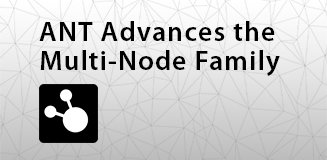 ANT wireless develops self-forming network as part of multi-node solutions suite
ANT wireless develops self-forming network as part of multi-node solutions suite
 ANT wireless develops self-forming network as part of multi-node solutions suite
ANT wireless develops self-forming network as part of multi-node solutions suite

Cochrane, Alberta – March 2, 2015 – ANT Wireless, proven innovator in ultra low power (ULP) wireless technology, today announces the newest addition to its family of multi-node solutions. The technology is a self-forming, self-healing multi-hop network in which nodes can appear and disappear seamlessly.
This newest addition to the multi-node family is the ideal solution for Internet of Things applications, and markets such as smart and connected homes.
The Family of ANT Wireless Multi-Node Solutions
ANT Wireless has an entire family of solutions to solve your multi-node problem. From simple systems to the Internet of Things, ANT multi-node delivers robust and reliable control from smartphones and tablets.
Shared Channel: The best personal area network solution, this polled network is suitable when a high node count (up to 65,000) is required in a small area and can be managed by a hub.
Sample use case: Action cameras: One camera starts and stops a group of cameras to get different, synchronized views.
Hub-to-Hub: The Hub-to-Hub solution dramatically increases the available network size by allowing shared channel hubs to communicate. Effective in static, installed environments that comprise multiple high node count areas.
Sample use case: Temporary/event shelters: Battery powered lighting is coordinated in tents from a central location.
Scan & Forward: Messages and commands are cataloged and forwarded to all nodes in a private distributed network. This solution lets you monitor and control broad and expanding areas using very high node count networks.
Sample use case: Parking or street lighting: one photo-sensing light tells all others when to turn on or off.
Continuous Scanning: For monitoring vast numbers of nodes, high power receivers track countless low-power peripherals whilst moving in and out of range, resulting in an extremely dynamic environment with very low latency and low power sensors.
Sample use case: Enterprise fitness: high power receivers receive fitness data from employee fitness trackers.
New addition to multi-node family: A battery optimized low power enabler for the Internet of Things. Self-forming, self-healing, secure multi-hop networks controlled directly from a smart phone. Available in 2015.
Sample use case: Connected candles (MWC 2015 demonstration): Any or every battery-operated candle in a set is controllable from multiple smartphones or remotes when in range of any candle.
##
About ANT / ANT+
ANT is an established protocol and silicon solution for ultra-low power (ULP) practical wireless networking applications. With over 100 million devices in the market, ANT+ facilitates interoperability between ANT+ products and the collection and automatic transfer of sensor data. Applicable in sport, wellness management and home health monitoring, ANT+ (built on the base ANT protocol) defines device profiles that specify data formats, channel parameters and network keys. Visit thisisant.com/directory for a complete listing of ANT+ certified and verified products.